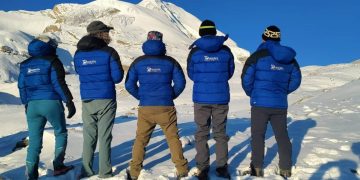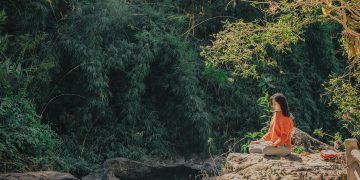It is not only the towering peaks of the Himalayas that draw countless trekkers to Nepal each year but also the promise of experiencing some spectacular landscapes Here everyone has a chance to stretch their legs and minds as well. The incentive for taking part in this trek is thus much more than just an opportunity to get closer views of some incredibly fine natural scenery it’s also one way people have to experience different cultures up close
Nonetheless, the joys of this journey are greatly increased when there is a Sherpa guide on the scene. Sherpas are famous for their expertise in high-altitude trekking, and with one next to you not only the risk of danger is gone — your feeling for the experience is greatly heightened
A Sherpa guide is an invaluable help in negotiating the often difficult off-road terrain on the Annapurna Circuit. Familiar with the trail and the local conditions as well as their own habits and customs, they know how to tell dangerous areas from others to be avoided and keep trekkers on course. Their understanding of the route means that when conditions change they can adjust the trek to suit: postponing a day so as not to gain too much altitude in which case get altitude sickness, or to let somebody rest who is feeling unwell. This helps prevent altitude sickness and makes the trekking journey safer and more enjoyable
The Annapurna Circuit Trek Cost is a tough trek, but the experience of a Sherpa guide ensures that you will not be too tired at any given time and probably won’t injure yourself eitherFurthermore, Sherpa guides provide more than just physical support. Many Sherpas come from communities along the Annapurna Circuit and they thus offer trekkers insights into local customs, traditions, and history that would otherwise go unnoticed. Their deep knowledge of indigenous cultures on the trail adds richness to the trekking experience It allows you to experience sacred sites in full, and to visit meaningfully with locals. It gives you a sense of the spiritual place where you are
From explaining Buddhist rituals in monasteries to telling stories about the history of the region, the Sherpa guide enriches the trek with a deeper cultural understanding that adds to layers of meaning to the journey . Furthermore, Sherpas takes care of the logistics, such as arranging accommodation and meals, helping make all arrangements for the trek run smoothly. Their help is particularly crucial in more remote areas where resources can be scarce. With a Sherpa guide, trekkers are free to concentrate on the great scenes around them without deep thought of practical matters
To sum up, a Sherpa guide makes the Annapurna Circuit from a physical ordeal into an edifying, enlightening, and safe experience. With their skills, know-how, and warm hospitality these people are an indispensable company on what may well be one of the world’s most magnificent treks.
An Introduction to the Annapurna Circuit
The route of the Annapurna Circuit trek is world-famous, an adventure that guides travelers through some of Nepal’s most varied and naturally stunning areas. The trek is also known for its stupendous landscapes – within sight are possibly three of the eight greatest mountains on earth: the Annapurna Range, Machapuchare, and Dhaulagiri. Spanning from 160 to 230 kilometers, the circuit leads trekkers from subtropical lowlands up into the heart of alpine deserts with dramatic changes in vegetation and terrain.
While keeping a steady tempo, the trip usually lasts for between 12 and 21 days, depending on one’s personal preference as well as side trips along the way. The Annapurna Circuit features some of Nepal’s most famous sections, and perhaps none is more iconic than the crossing of Thorong La Pass at an elevation of 5,416 meters. First, look at majestic snow-capped peaks; then walk through dense forests that seem to contain the essence of life. On some routes, trekkers can get a taste of the remote mountain cultures.
On your trek, you will pass through picturesque villages like Manang, Pisang, and Jomsom, each with its own history and culture. The trip caters to those with moderate physical abilities, but time should be left aside for acclimatization against altitude sickness. Annapurna is suitable for anyone who wants a journey that is both thrilling and challenging. As well as scenic sights, you’re guaranteed a peep into the way of life here on the Himalayan heights – that’s something to remember always.
The Role of a Sherpa Guide
A Sherpa guide is essential to the success and safety of trekkers on the Annapurna Circuit Trek Itinerary. Sherpas are mountain professionals; born and raised in the area, they understand local conditions better than anyone else in addition to doing an expert job of high-altitude trekking. Traditionally, Sherpas have lived in the Himalayas for generations and this mountain connection gives them a rare insight. Sherpa guides are highly capable of managing trekking groups, not only in terms of offering logistical support but also looking after trekkers to keep their trek healthy and comfortable. They know what is involved in a trek at this altitude, in terms of its physical demands and risks such as altitude sickness. Having a Sherpa guide can considerably reduce the dangers involved in trekking such a challenging landscape and many of them are qualified to help with emergency first-aid treatment if anything should occur! And they eagerly embrace their traditional peacemaker-cum-postman role in the Himalayan cooperative society too: unity makes strength.
Beyond mere guiding tasks, Sherpas are also knowledgeable sources of local culture. Many Sherpas are of the ethnic group from which the term originally hails, and they have a deep knowledge overlapping with Buddhism and Hinduism in this region. This is rooted in their advice and experience – two things that make a smooth and demanding Annapurna Circuit adventure Benefitsof trekking with a Sherpa Guide The benefits of going on an Annapurna Circuit Trek with a Sherpa guide are manifold. One important piece of evidence has to do with local knowledge: the sherpa, whose terrain It is Sherpas have a fine scene on every trail, though, and if trekkers do encounter a new unexpected complication the sherpas not only know which way to go through it but usually have an idea of how long it will take.
Another big advantage comes from the Sherpa’s expertise in high-altitude management. The Annapurna Circuit hits high altitudes, and altitude sickness can be a danger. Sherpa guides are skillful at spotting signs of altitude sickness early on, and know how to deal with the problem: either by reducing the tempo of the trek, or by suggesting rest periods so that trekkers can become acclimatized.
Sherpas furthermore convey a rich store of cultural knowledge and offer precious glimpses into local lifestyles, religion, and history. They are able to bridge the cultural gap between trekkers and local people. And as a result, your whole experience takes on a more authentic and respectful character. Whether talking about what Buddhist monasteries signify, or preserving village customs, it is a way of looking at the Annapurna region that can’t be enjoyed by those without knowledge behind them–you get all sorts of stories from Sherpas on the way.
Finally, Sherpa guides can handle details such as finding places to stay, food, and permits, allowing trekkers to concentrate on enjoying their trip itself.
Skill as Navigator and Safety Expert
The Annapurna Circuit Trek is a tough journey that takes in various altitudes, changing weather patterns and rough terrain. But when there’s a Sherpa guide at your side, trekkers take full advantage of their expertise in navigation and safety over the entire trek. They are experienced professionals who know every inch of the trekking routes, so groups stay on the right path, don’t get lost, and make productive use of time.
Sherpas are trained to deal with the many hazards life may hold in store, from changes in weather to unfamiliar or difficult areas. Sherpa knows the safest route, how to work out hard places, and when it is necessary under these circumstances for a group to change its plan of advance. Moreover, Sherpas are adept at employing maps, GPS devices, and other gadgets to steer their way along the often challenging trails of the Annapurna Circuit.
Sherpa guides are trained to be extremely aware of safety and can deal with such potential risks as altitude sickness, injury, and even emergency evacuations Should the need arise, they provide basic medical help or arrange for an evacuation to a lower altitude. They ensure trekkers are well prepared for any situation and their advice cuts risk to a minimum, making such an experience far, far safer. Personal Observations on the Culture of the Annapurna RegionOne of the most rewarding aspects of doing the Annapurna Circuit Trek is that it allows you not only to see beautiful scenery, but also to experience people’s unique cultures and customs at firsthand. Sherpa guides are locals themselves, so they are able to give trekkers an insider’s view of the communities, traditions, and religious practices that make the Annapurnas so special a place to visit. As you trek through villages like Manang, Pisang, and Chame, your Sherpa guide may point out such things as:- the reasons for Buddhist and Hindu the significance of sacred the past history of the mountain communities have a deep bond with their culture and their stories help to give a rich understanding of the customs in the region which they live. Your guide might take you through some of the local customs, such as burning butter lamps in monasteries, stupa visits, or spool prayers. Sherpas also give personal accounts of their life in the Himalayas, which offer an intimate a very real look at the people who live here in these mountains. This mutual cultural exchange becomes one of the most memorable aspects of the entire trek and it brings the journey closer to home for many trekkers. As well, Sherpas can get people to start using their own hands and mouth! They familiarize trekkers with traditional foods and arrange conversations with local folks, making the journey both more profound and richer.
Get fit and acclimatized, then monitor your health.
High-altitude treks like the Annapurna Circuit require acclimatization; Sherpa guides are invaluable for ensuring trekkers do this safely at ever-increasing altitudes. The trek is followed by a rocky hill path that involves considerable altitude gain. The importance here cannot be overstated this hill phase also preparation you for Thorong La Pass (5416 m). If trekkers don’t acclimatize properly they run the risk of altitude sickness, which can undermine both the enjoyment and experience of a trek–or even result in death.
The Himalayas are an environment Sherpas are also experts in. Without their knowledge of how to set a pace suitable for optimal acclimatization, trekkers would quickly find themselves out of breath and far from home territory. They structure the itinerary as such that trekkers move up slowly, spending time in key villages like Manang. In these bases of operation, the hikers use their rest days to “climb high and sleep low”–in other words, hiking to higher elevations during one day and then returning lower down at night. This allows their bodies to acclimatize by stimulating the production of red corpuscles, a process that is essential nevertheless costly when it comes amid low oxygen flow.
The Sherpas are also skilled at spotting early signs of altitude sickness in trekkers: headaches, dizziness, and nausea. With extra vigilance for their client’s health, they are constantly monitoring it, telling them to slow down when necessary, take a breather day here and there if warranted by personal needs as, and even descend to lower elevations– when this is appropriate. Thus the risks associated with this condition are limited, enhancing throughout a trek for safety.
Personalized Trek Experience
Hiking with a Sherpa guide gives you a more personal touch and lets hikers enjoy tailor-made itineraries, and individual attention all along the trail. According to preferences, abilities, fitness Esteemed GuideSounds Good! levels of the group, Sherpas can adjust a trek so that everybody has a comfortable and pleasurable time.
A Sherpa guide can even help modify the route if specific interests such as photography, wildlife observation, or understanding local cultures are important to you. In these cases, in every hillside monastery, sunlight shafting through the early morning mist to illuminate a village path, or unusual but edible wild vegetable becomes a once-in-lifetime experience.
Booking accommodation and arranging meals–all will be taken care of by a Sherpa guide. So that the trekker doesn’t have to think about such details, and can instead relax and enjoy walking. This personalized treatment brings joy and psychological satisfaction to trekking. It makes the whole experience more rewarding all around.
Sherpa guides: Professional Assistance in Case of Emergencies
Annapurna Circuit Trek Difficulty Emergency evacuations from the slopes of Everest and other big peaks to real hospitals in Kathmandu are now fairly routine procedures. They can save your life–but you do need to have someone with such experience around for when things go wrong. In this difficult situation it was critical that my guide take over effective communication with other people in order to get help in time.
A Sherpa guide on hand also means that you will always have the vital support necessary for an emergency whenever it should occur. Sherpas are trained in first aid and have abundant experience dealing with pretty well any problem that could arise on a trek–injuries, altitude sickness, or just plain tiredness.
Should you succumb to altitude sickness or have an accident, your Sherpa guide is right there to administer immediate first aid. They are well acquainted with the symptoms of mountain sickness and can give you advice as to what steps need to take: for example, telling you when to take some drugs (with what kind of dose according to whether or not it’s mild), should try going lower altitude, etc. In more serious situations, Sherpas can initiate evacuation proceedings–this guarantees that if required you will receive timely medical attention.
They know these mountains inside out. A group of walking interventionists who are former porters, stellar guides, and English-speaking companions to boot. For instance, when you launch a trip to the Himalayas with us we not only provide experienced Sherpas but also offer a detailed emergency plan. As much as arranging helicopter evacuations or guiding people to the nearest medical facilities may become second nature to their leaders; emergency manager of this kind can well be life-saving. In addition, there is no price for the amount of security a Sherpa guide’s presence can add to your trip, the peace of mind it gives you, and the sheer know-how that even an experienced trekker might never catch up with.
Environmental Responsibility and Sustainable Trekking
The Annapurna Circuit Trek is a journey through the finest scenery in the world. However, with an ever-growing number of hikers traveling on foot each year, the preservation of nature has become a real problem. Sustainable trekking practices are essential for preserving the natural loveliness and ecological balance of the Annapurna Conservation Area. One way to guarantee responsible hiking is to employ a Sherpa guide, who feels deeply committed to this land and its preservation.
Sherpa guides know perfectly well how to tread lightly on the earth. They bid trekkers to take only what water they truly need and to carry out all non-biodegradable waste with them. They also advise against using plastic products (which are hard to dispose of in remote places) and so forth. Many of them also advocate the use of biodegradable toiletries, so that no harmful chemicals can get into natural water sources. They know the environment and so help trekkers to move with it in wise ways, avoiding damage to delicate systems. They help save endangered species by keeping on marked trails and shooing the animals.
In addition to practicing their own way of eco-friendly trekking, Sherpa guides often work with local communities in order to push forward some eco-tourism projects that can make a stand for preservation. They see to it that hikers are aware of the region’s environmental problems and support local efforts to guard the earth. This engenders a sense of joint responsibility, giving the trek a richer experience and supporting the long-term protection of Annapurna itself. By having a Sherpa guide take you by the hand, as it were, one is not only on a safe and carefully conducted journey; one also becomes part of the effort to preserve the environment in this part of Nepal. The Annapurna Circuit will still be running through for generations, thanks to sustainable trekking practices and local knowledge2.
The background is the Key to Unknown Regions
Panoramas and remote backwater villages like at The Annapurna Circuit Trek Package Tradition of the Old Chinese Secret Vine Coated Cottage but it also contains scores of hidden gems best discovered with a local guide or guide. Sherpas are not only accomplished navigators; they are also fanatical caretakers of their region’s wildlife and natural beauty. Their intimate knowledge of the locality allows trekkers to venture into areas that are not found in any tourist literature or other guides.
Accompanying a Sherpa on the Annapurna Circuit, you’ll constantly discover misty valleys featuring concealed hideaway monasteries and wild waterfalls. You will find a vantage point with panoramic views of the surrounding mountains which can not be found by most other tourists. Sherpas know the hidden places of the region to take a tourist. For example, they might introduce you to local tea houses where you can meet the villagers, participate in their activities, and take part in special forms of entertainment or ritual practices that are unknown to outsiders.
Moreover, a Sherpa guide knows the terrain better and can help you appreciate the natural beauty of the Annapurna region from a more human standpoint. They will be able to point out quiet spots for contemplating or meditating to yourself–and then absorbing fully into your whole being where rest reigns supreme.
Such close links with the countryside and its communities enable Sherpas to offer a trek that is both more authentic and more enriching. There are numerous gems off the beaten track for those without a guide to miss out on which the Sherpa guide will show you.
Trek with a Sherpa Guide and Add Hidden Gems to the Annapurna Circuit
A tension-free time when trekking To be sure, trekking in the Himalayas – especially around the Annapurna Circuit – is physically tough and mentally harrowing. But if you really want to enjoy it all the way, you must be sure that the trek is stress-free. And to help you out on this, there is simply nothing more perfect than having a Sherpa guide in hand. A Sherpa guide looks after the logistics and helps take away all the worries, so you can concentrate on just how lovely the capitalist nature around you looks without having a care in the world about tiny details. The comfort that comes from this will make your trek one hundred percent better than any other way it could possibly be done. In addition to guiding you through the course, The biggest benefit of using a Sherpa guide is the ease with which you acclimate to the trail. If you start lower than 800 meters and then ascend above 5,000 meters during your trek, things become difficult. With a Sherpa guide, however, it’s all a breeze and as pleasant as walking in the park. A Sherpa guide knows fully well the path, including where to rest, where to eat, and where to sleep; which makes trekking life much easier. He or she also keeps a close eye out for the weather and if necessary adjusts your schedule so you ‘re always traveling under ideal conditions.
In terms of simple support and extra motivation, Sherpas also offer psychological backup for the trekking which proves to be especially valuable on this kind of trek. Their familiarity with altitude sickness, weariness and the mental problems that barriers produce mean they can always keep trekkers concentrating and relaxed; indeed they do often serve as a reassuring hand-hold when the going gets tough-tolled out so that weary travelers can take hold of that renewed strength and go farther still. They also help out with tasks such as carrying your pack, finding lodgings, and ordering meals, making the whole thing far less stressful than it would otherwise be. Ultimately, having a Sherpa guide means that you can throw off the worries about planning and finding your way – in other words,s be sure to fully enjoy each moment of your trek around Annapurna Circuit with a carefree mind. After all, it’s not possible to get back from five thousand meters down to eight hundred in one day…
The History and Tradition of the Sherpa People
The Sherpas, who are adept mountaineers, have for centuries been a unique part of Nepal’s trekking and climbing culture. Their rich history is inextricably linked to the Himalayan region, and it has been this that has helped shape their lifestyle. is a view to sharing the risks and expenses of mountain travel.
Originally coming from Tibet, Sherpas settled in the temperate zones of Nepal at elevations approaching 4,000 meters where they adapted and refined a special set of skills that allow them to flourish in one of the world’s most challenging environments.
The Sherpa people are known for their adaptability, resilience, and unusual endurance levels–all absolutely essential if they want to stay alive or prosper amidst the harsh conditions of the Himalayas. Having passed down these traits from one generation to another, Sherpas make an ideal guide for high-altitude trekkers such as those on the Annapurna Circuit. Their intimate knowledge of the mountains, climate, and routes is incomparable, while the warmth and hospitality shown to visitors leave travelers with warm memories of an unforgettable journey.
Traditionally, the Sherpa porters had been porters and traders since time immemorial; but in the early 20th century when they began working as porters for Western climbing expeditions attempting to summit Mount Everest, this association with mountaineering took the form it has today. Over time, the knowledge and skills of Sherpa porters working on Mount Everest grew and deepened increasingly they became patrons of some of the greatest campaigns in history that shaped modern mountaineering and re referred to fondly by Tibetans as father ( your grandpa ).
Today the Sherpa people are well known not only for their professional guiding services but also for their deep cultural traditions–their Buddhist beliefs, in particular, influence the way they view life and work.
Traveling with a Sherpa guide not only puts alongside you a knowledgeable and skillful companion but it is also an opportunity to discover the culture, history, and values of the Sherpa people, thus adding another whole layer of meaning to your Annapurna Circuit experience.
How Your Trekking Experience Gets Better With a Human Guide
A Sherpa guide can make all the difference on a trek, for example on the Annapurna Circuit. This is especially true when we consider how in particular Sherpas help you think in multiple ways: from facilitating your trekking journey with insight and experience down to guaranteeing that a trip that might otherwise be perilous turns out to be anything but challenging.
Annapurna Circuit Trekking Route They know all about the trail because they’ve been at it for so long. A Sherpa guide is indispensable when you’re faced with coming upon hard terrain cover up close at a run, the weather shifts all of a sudden on an unprotected northern slope, or simply when the altitude is changing from one end to the other of this circuit.
The Sherpas are great high-altitude trekking experts too. They understand how to help climbers become acclimated to the altitude, minimize dangers arising from high-altitude symptoms, and manage their pace throughout the trek. Their understanding of good routes and smooth places in which rest ensures that you keep up a steady clip, something which prevents weariness and is easy on the body.
furthermore, with Sherpa guides one-to-one support minimizes unnecessary hardship: they stand up for you and advise on when to stop or go, ensuring your energies are spent as effectively as possible. This is especially important when trekking at higher altitudes, where weather conditions can change suddenly and where the physical strain starts to set in.
In general, no matter whether Sherpas are managing accommodation, arranging meals, or ensuring that these details do not transfer you some work they are actually performing a job. This kind of support means that you will be able to trek ltself relatively stresslessly and without a hitch.
But perhaps the biggest bonus to having a Sherpa guide is that they provide cultural enrichment for your trip. As well as being skilled trekkers, Sherpas also act as ambassadors for Nepalese culture. Thus they will tell you stories and explain traditions to you along the way, and you can visit local mossies in between. By the time the trek has finished, your guide has not only ensured that the journey was safe for you, but also attractive.
The Value of Having a Sherpa on Board. Annapurna circuit trekkers face a key decision: whether to hire a Sherpa guide. In the end, all the added costs for one guide might at first appear like unjustified expenses to you. But given that it’s immeasurable and truly worth every penny when you consider how much value your Sherpa guide will deliver in terms of safety, cultural enrichment, and logistical support, there can be no reason for not to decide to hire a local Nepali with expertise inside out!
One main reason it pays to have a Sherpa guide is that it is secure. Trekking in the Himalayas at high altitudes, in any mountain area ̄is risky. A Sherpa guide knows how to negotiate difficult terrain and deal with altitude-related problems ¿ ensure that your trek can be done without placing you at risk personally. At the same time, they also provide advice on acclimatization, decreasing the likelihood of acute mountain sickness, and making certain that you trek at a suitable speed. Such professional expertise is invaluable, as it can mean the difference between a successful trek and one that ends up being unsafe. n Beyond security, a Sherpa guide has something more to offer; they can enhance the cultural aspect of trekking. “They possess vast local knowledge,” says one man who has been trekking with guides for over 20 years now and still doesn’t regret a single day’s experience of it. “Their culture and traditions are introduced to us. We learn about local customs, and history in short we’re introduced to the social system of their communities. The result is that the trek becomes richer, and more meaningful. This gives you a never-to-be-missed chance to enter into another world by communicating with its people and communities through all five of your senses. Sherpas are also there to offer emotional support and encouragement, most particularly in situations where trekking becomes a physical threat.
A Sherpa guide handles everything from soup to nuts. He arranges your meals and accommodation, carries your pack for you and everything on it, and makes sure the trek goes according oa plan. This level of service saves trekkers themselves considerable trouble when in practice it amounts to enabling them simply to enjoy their journey without worrying about any details that are not already covered by the general supervision of the trek.
In conclusion, whilst hiring a Sherpa guide may add to the cost of the trek, the safety, cultural insight and overall trekking experience they provide is an investment that pays off in myriad ways.
How to Prepare for Your Annapurna Circuit Trek with a Sherpa Guide
Getting physically ready, mentally prepared and organizing logistically is what it takes to prepare properly for the Annapurna Circuit trek with a Sherpa guide. The first step is to find a reputable trekking agency, such as Sherpa Expeditions Agency. They offer trekking guides who are experienced in every detail of the route and are high-altitude experts.
According to Fat, successful trekking on the Annapurna Circuit requires physical preparation. It’s a long, hard, and physically exerting journey that demands strength, endurance, and great flexibility. So, trainers should be just what you need. A fitness regimen involving cardio workouts, weight training, and hikes is highly recommended. Just as important as being physically ready is mental readiness for such a trek. It’s long, hard, and arduous: to carry on keeping their spirits up and maintaining a positive mental attitude is in fact the key for all trekkers to get through.
When trekking with a Sherpa guide, the guide will help you prepare: for packing, with formalities such as whether you need visas or special permits, and all the practical things of the trek. He will also advise on altitude sickness prevention, acclimatization schedules, and pacing for the trek. This will ensure that you enjoy your trip and stay comfortable throughout it without any health problems whatsoever. In addition, your Sherpa guide will manage the daily logistics, such as finding accommodation, getting meals at the right times, and arranging everything so your trekking experience is as smooth as possible. They take care of all the details without you having to worry, leaving you free to just do the trek itself.
Manageably, preparing for the Annapurna Circuit trek with a Sherpa guide takes care of this and lets you get on with the adventure.
In conclusion, Why You Need to Hire a Sherpa to Take You on your Annapurna Trek
Annapurna Circuit Trek Guide The opportunity which for many is a once-in-a-lifetime one-how, then Heretofore geese you have never seen knot One fly away a Daniel Boulud France-seared Sherpa guide can actually heighten it in butterflies. Yes, from their expertise in high-altitude trekking up there in one of the most famous mountain ranges worldwide but not known to all Westerners; Sherpa guides genuinely do play an important part in delivering tourists an entirely safe, educating, and unforgettable experience.
These Sherpa guides know their trail. Not only do they think ahead of you, but they are also always ready for what is to come. When you trek with them, you feel that you are being taken care of and can rely on everyone the trek goes smoothly. More enjoyable!
Besides all that, a Sherpa guide can give one many chances to look at the history and culture of the Annapurna Region from different angles. In this way, he makes our trek not only more free from worry but adds another dimension altogether. For now, the Annapurna Circuit is turning physical and spiritual upwards, don’t be surprised if it also becomes an adventure of self-discovery.
With a Sherpa guide, all your logistical issues, from booking meals to arranging accommodations and making room for yourself to return after an emergency evacuation back at base camp are taken care of. On top of this is a great morale boost: because you know that the natural world around in these parts will not have changed for decades if not thousands of years. Plus, with their support keeping things smooth and easy rather than tense and stressful as we might otherwise be prone towards 24/7 with nothing left to do except try earnestly thinking about politics as best one goes along–but only if he wishes!
Annapurna Circuit Trek Itinerary Thus in one word hiring a Sherpa guide is not just about seeking directions to the path. Especially for those who do not know anything about trekking such as beginners standing at an altitude of 6000 meters or the tallest mountain peaks as is the case with Annapurna; hiring a Sherpa guide is indispensable in order to be able explore and enjoy life there.































